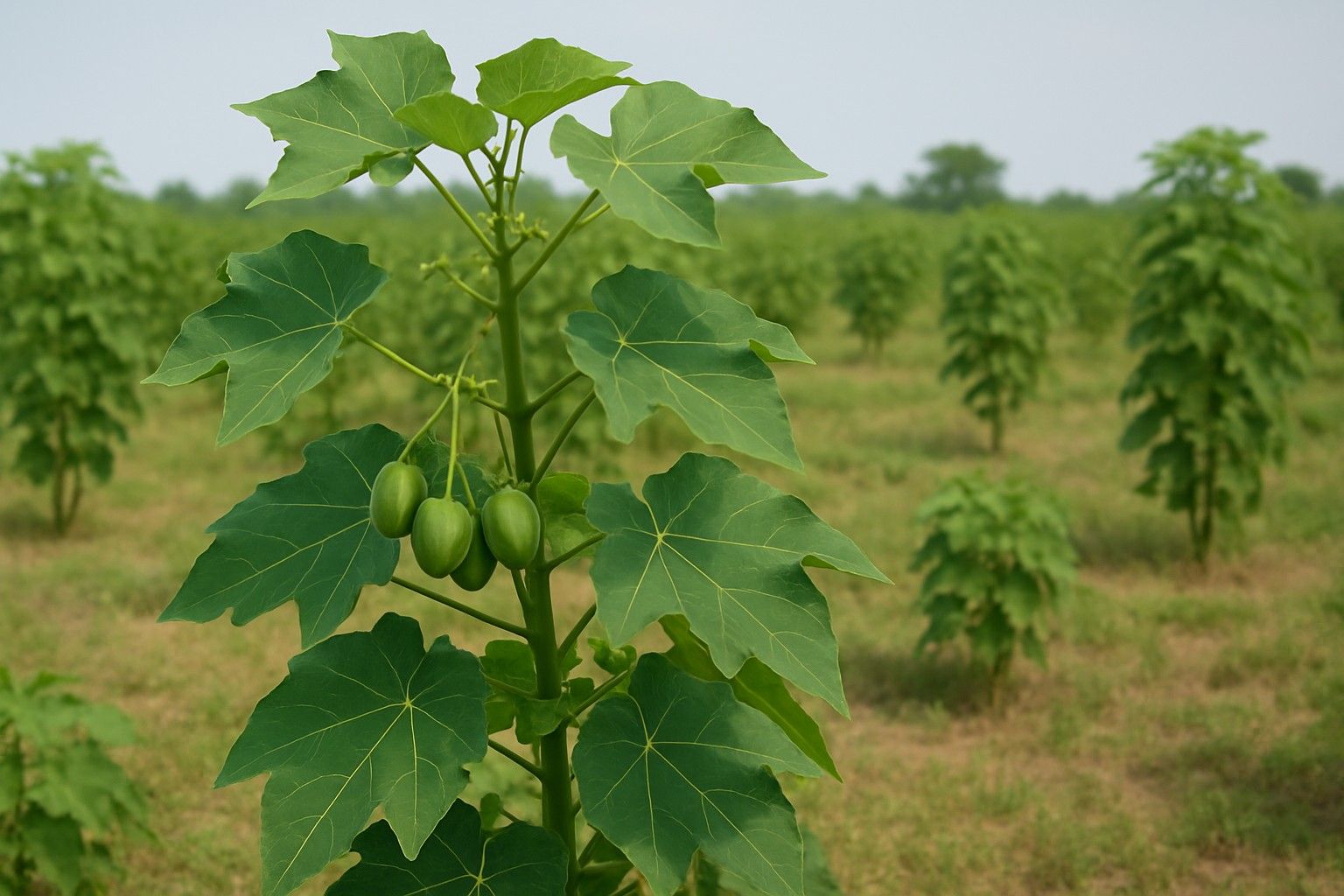Jatropha curcas is a multipurpose plant known for both its medicinal properties and its potential in biodiesel production. There has been growing interest in its seed oil as a biodiesel source has led to large-scale cultivation of the plant. Jatropha curcas, a perennial plant from the Euphorbiaceae family, which produces seeds containing 31–37% oil, which can be used directly as fuel without much refining. Through the process of transesterification, this oil can be converted into biodiesel. Jatropha curcas commonly called ‘‘Ratanjot’’ in Hindi, ‘‘Kattamanakku’’ in Tamil is a multi beneficial shrub of significant economic importance as Biofuel.
Jatropha can thrive in marginal or degraded soils with minimal agricultural input, including rocky, shallow, and low-fertility wastelands. In addition to having a high cetane number, Jatropha oil significantly reduces harmful emissions—cutting carbon monoxide by 44%, sulphates by 100%, and ozone-forming potential by nearly 50%. Cultivating Jatropha not only provides a sustainable source of biodiesel but also offers significant employment opportunities, particularly in agricultural economies like India.
Figure 1: Jatropha plant containing seeds which produces oil
Botanical Description
Jatropha curcas is a drought-tolerant shrub or small tree that grows naturally or in semi-cultivated conditions (Kumar and Sharma, 2008). Depending on soil quality and rainfall, oil extraction from its seeds typically begins 2 to 5 years after planting. The plant yields between 0.5 and 12 tonnes of seeds per hectare annually.
Leaves
The leaves are typically simple and deeply palmately lobed, with 3 to 5 lobes. Stipules are generally reduced to ciliate glands. The venation is palmate. Leaves range in color from green to pale green, are broad, and glabrous (smooth and hairless).
Inflorescence
The inflorescence is complex, with the primary branching being racemose and the subsequent branches cymose. It is borne either terminally or in the leaf axils. Female flowers are usually slightly larger than the male ones. Small, yellowish-green flowers are arranged in loose panicles of cymes.
Fruits
Following pollination, the fruit develops into a schizocarpic capsule, typically three-chambered, which splits into three one-seeded segments (cocci). The seeds often have a prominent caruncle and resemble castor seeds in shape—ovoid, oblong, and black. The capsules mature and turn from green to yellow approximately two to four months after fertilization.
Medicinal Uses
Jatropha species are grown as hedge plant in live fences and are administered to treat various diseases.They are reported to be abortifacient, anodyne, antiseptic, cicatrizant, depurative, diuretic, emetic, hemostat, lactogogue, narcotic, purgative, rubefacient, styptic, vermifuge
vulnerary, homicide, venereal disease, etc. and its latex to bee and wasp stings and to dress sores and ulcers and inflamed tongues and inhibitory to watermelon mosaic virus. Several compounds have been reported from different species of Jatropha. Biological activities such as anti-leukemia and anti-nasopharyngeal, antitumor, anti-diarrheal activity, anti-inflammatory activity, anti-coagulant activity, haemostatic, antimalarial, wound healing, etc
Sources of Biodiesel
Biodiesel can be produced from various oilseeds and plants. In the Indian context, only non-edible oil-producing plants that can be cultivated on a large scale in wastelands are considered suitable. However, some oilseed plants in India possess significant medicinal properties, making them less viable for fuel production. Taking these factors into account, the most promising biodiesel-yielding plants in India include:
- Jatropha curcas (Ratanjot)
- Pongamia pinnata (Karanj)
- Calophyllum inophyllum (Nagchampa)
- Hevea brasiliensis (Rubber seed)
- Calotropis gigantea (Ark)
- Euphorbia tirucalli (Shrub)
- Boswellia ovalifoliolata
These species are well-suited for biodiesel production due to their adaptability to poor soils and non-edible oil content.
Characteristics of Jatropha curcas Oil and Its Biodiesel Potential
Vegetable oils typically have properties that differ significantly from conventional diesel fuel. However, with proper processing, oil can be refined into biodiesel with characteristics comparable to standard diesel, making it suitable for use in a variety of diesel engines.
Crude protein levels ranged between 31–35%, while fat content varied slightly between 55–58%. Some regions showed even higher protein content..Jatropha meal fiber content was found to be lower than that of soybean meal but similar to Jatropha provenances from Cape Verde (4.7%), Senegal (5.6%), Burkina Faso (5.3%), India (4.5%), and Nicaragua (4.5%). Whole kernels showed a gross energy content ranging from 31.1 to 31.6 MJ/kg, and both total soluble sugars and starch content were below 6%.
Jatropha seed oils, which contained oleic, linoleic, palmitic, and stearic acids. Oleic acid was dominant in samples from Veracruz, while linoleic acid was most abundant in samples from Morelos—differences attributed to varying soil and climatic conditions. Overall, the oil is rich in unsaturated fatty acids, primarily oleic and linoleic acids. So different areas show different constituents of fatty acids.
In crude Jatropha curcas oil (CJCO), oleic acid is the most abundant fatty acid at 44.5%, followed by linoleic (35.4%)
Advantages of Biodiesel
- Biodiesel is environmentally friendly, biodegradable, non-toxic, and virtually free of sulphur, lead, and aromatic compounds.
- As a domestically produced renewable energy source, biodiesel reduces dependence on imported fuels, helping conserve valuable foreign exchange.
- With a higher cetane number than conventional petrol or diesel, biodiesel enhances engine performance. Studies have shown improvements in fuel efficiency, horsepower, torque, and haulage capacity when compared to traditional diesel.
- Biodiesel offers superior lubricating qualities, which enhance engine durability and efficiency.
- Biodiesel consists of simpler hydrocarbon chains and lacks the sulphur and aromatic substances commonly found in fossil fuels.
- Containing up to 10% oxygen, biodiesel ensures more complete combustion, improving overall fuel efficiency.
- Biodiesel significantly reduces harmful emissions. It eliminates lifecycle emissions of carbon dioxide and sulphates, and lowers particulate matter by 40%, unburned hydrocarbons by 60%, carbon monoxide by 44%, polycyclic aromatic hydrocarbons (PAHs) by 80%, and carcinogenic nitrated PAHs by 90%.
Jatropha as a Prime Source of Biofuel
Jatropha curcas is widely recognized as one of the most promising species for biofuel production among Tree Borne Oilseeds (TBOs), owing to several key advantages:
- High Oil Yield: Jatropha offers one of the highest oil yields per hectare among TBOs. While comprehensive data on seed yield for various TBOs is still limited, the largest Jatropha cultivation in India—located in the Nashik district of Maharashtra—reports average yields of 1 to 1.5 tons per hectare per year. Although some claims suggest yields as high as 10 tons per hectare annually, these are considered unrealistic, especially under rainfed conditions.
- Short Gestation Period: Jatropha can begin bearing fruit as early as the first year after planting, though initial yields are low. By the second year, it generally starts producing seeds, resulting in a short gestation period and an attractive cost-benefit ratio for farmers.
- Climate and Soil Adaptability: The plant thrives across a wide range of climatic and soil (edaphic) conditions. It can grow in low-rainfall regions receiving as little as 200 mm annually, and also performs well in high-rainfall or irrigated areas. It is suitable for eroded and nutrient-poor soils.
- Low Soil Requirements: Jatropha is not particular about soil type and does not require tillage. It can grow even on alkaline and degraded soils.
- Hardy and Low-Maintenance: It establishes easily, grows rapidly, and is hardy. Its unpalatability to animals makes it resistant to browsing.
- Ease of Seed Collection: The seeds are easy to harvest, as they mature before the onset of the rainy season and the plant remains relatively short in height.
- Simple Propagation: Jatropha can be propagated easily through seeds, seedlings, or vegetative cuttings. Using branch cuttings is especially effective and promotes fast growth.
- Versatile Land Use: It can be cultivated on a variety of land types, including watershed areas, low-fertility lands, degraded, marginal, fallow, or wastelands. It is also suitable for planting along canals, roads, railway tracks, and field boundaries. When grown along field bunds, it serves as an excellent live hedge or natural fence.
These attributes make Jatropha curcas a highly suitable and sustainable option for large-scale biofuel production, particularly in regions with underutilized or degraded land resources.
Limitations of Jatropha
While Jatropha curcas has significant potential for biofuel production, it also comes with certain limitations that must be carefully considered:
- Jatropha cannot be cultivated on waterlogged soils or steep slopes exceeding a gradient of 30°.
- The plant thrives best under specific climatic conditions—annual rainfall should not exceed 600 mm in moderate climates and 1200 mm in hotter zones. Additionally, soil pH should remain below 9. Jatropha is sensitive to cold and ground frost, making it unsuitable for areas where temperatures drop below 0°C.
- The seeds of Jatropha are hard and contain toxic compounds, which can pose risks if not handled properly.
- Early growth is hindered in young plants which are vulnerable to damage by the golden flea beetle (Podagrica spp).
- Jatropha is highly prone to the Cercospora fungus, commonly known as “frogeye,” which is also found in tobacco crops.
– Dr Geetika Singh, Assistant Professor
Department of Biosciences, Faculty of Basic and applied Sciences
Madhav University, Sirohi, Rajasthan

